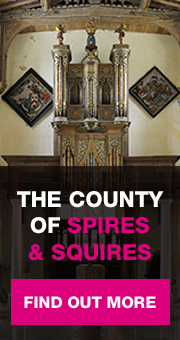13th April 2017
Macabre mediaeval Rothwell
Here’s a suggestion for a visit to a historic site that is almost unique in Britain, and it is so surprising and unexpected that it is well worth a visit.
On a beautiful spring day I couldn’t wait to leave the warm sunshine and to go down into cold dark and mysterious depths to explore one of the most astonishing collections in Northamptonshire.
The Bone Crypt underneath the church of the Holy Trinity in Rothwell.
Rothwell is an ancient town, founded by Danish invaders who named their settlement ‘Red Well’ after the local iron rich water. Nine hundred years ago the church construction began and over the next four hundred years it developed until it was almost cathedral like in scale. Holy Trinity church was on a pilgrimage route, and had an important relic, claiming to be a fragment of Jesus’s true cross. Relics were a massive real draw for the mediaeval tourist seeking blessings and the granting of wishes. The church reached the peak of its magnificence just in time for Henry VIII’s Reformation in the 16th Century, when it lost the patronage and support of Cirencester Abbey. Decline set in soon after, chapels, the north and south transepts and its spire were lost. And the charnel house, or bone crypt was forgotten.
In medieval times bone crypts were not uncommon. After the flesh had rotted away from a cadaver, the bones were carefully collected and stored in a communal space where they could be visited and prayed over. There was good money to be made by a church which could offer a holy final resting place, with prayers said on behalf of the deceased to help speed their way through purgatory to reach heaven as soon as possible. After the Reformation this practice was absolutely forbidden, so the crypt was closed.
It wasn’t until the 18th Century that a grave digger discovered the crypt by falling into it. Imagine his shock to discover that he was in the presence of around 2500 disarticulated skeletons…
The church has a team of committed and knowledgeable volunteers who are very happy to show you the ancient church, and the astonishing crypt is a thrilling visit. I was shown around by husband and wife team Janet and Roy Clements. Roy led us down into the crypt, warning us to mind our heads on the low ceiling, and to mind our feet on the uneven steep and twisting stairs.
Down we went and then suddenly we were faced with death.
The walls are lined with shelves of skulls, and the centre has two large cages full of carefully arranged bones. Roy explained that recent research by Sheffield University has identified that there are bones from mediaeval times, and also some from the 18th century. They appear to be the remains of men and women who died of natural causes - not as some had speculated the dead from a battle, or victims of the plague. One skull shows signs of trepanning, another with a craniotomy. Excitingly there are plans to put a face to at least one of the skulls, with a restoration to let us ‘see’ one of the dead as they looked in life.
Today it is rather humbling to be in the presence of so many ‘people’ in such a small space. It’s hard not to consider one’s own mortality, but it is not at all spooky. Roy was respectful of the humanity of the remains, and viewed them with a degree of affection. After all, they are some of the oldest residents of Rothwell, and our neighbours from the past.
Scores on the ancient Church doors?
Friendly and welcoming volunteers: 5/5
Sense of connection with the past: 5/5
Total surprise and amazement: 6/5
Rothwell Bone Crypt is open for tours on Sunday afternoons in summer. For more information visit www.rothwellholytrinity.co.uk
Your login details have been used by another user or machine. Login details can only be used once at any one time so you have therefore automatically been logged out. Please contact your sites administrator if you believe this other user or machine has unauthorised access.







